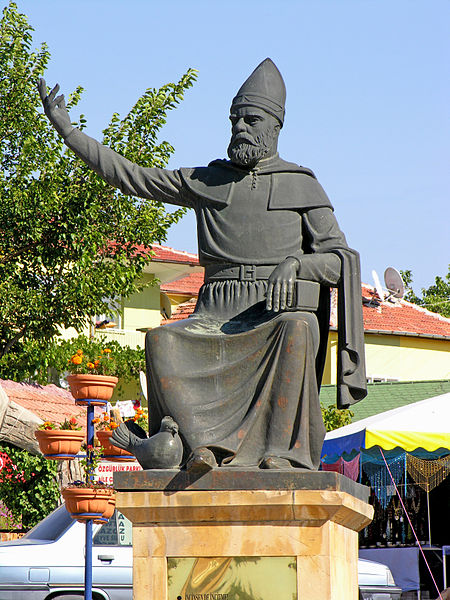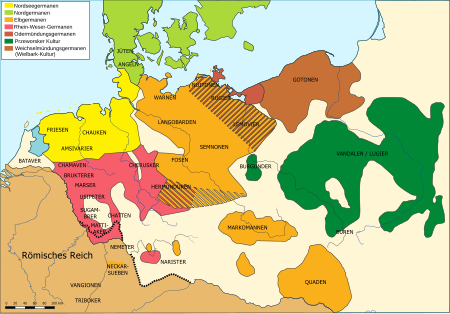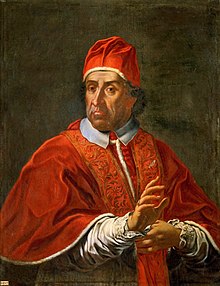Pope Clement XI
| |||||||||||||||||||||||||||||||||||||||||||||||||||||
Read other articles:

Matsumoto Kōshirō IV as Sakanaya Gorobee karya Tōshūsai Sharaku Sebuah hachimaki (鉢巻) adalah ikat kepala yang menjadi salah satu budaya orang Jepang, yang biasanya dibuat dari kain berwarna merah ataupun putih sebagai simbol semangat bangsa Jepang dalam bekerja serta menunjukkan ketekunan dan keseriusan pemakainya. Penggunaan hachimaki dipercaya dapat meningkatkan daya konsentrasi saat bekerja dan belajar. Hachimaki digunakan oleh siapa saja dengan profesi apa saja seperti pelajar, karya…

Edizione del codice di diritto canonico del 1983 Il Codice di diritto canonico (abbreviato in CIC o anche CJC, dal titolo latino Codex Iuris o Juris Canonici)[1], è il codice normativo della Chiesa cattolica di rito latino (alle Chiese sui iuris è dedicato il Codice dei canoni delle Chiese orientali). Il nuovo codice è stato promulgato da papa Giovanni Paolo II il 25 gennaio 1983 ed è entrato in vigore il 27 novembre dello stesso anno. L'idea di produrre un nuovo codice, che sostitui…

Pulau TomiaPeta lokasi Pulau TomiaNegaraIndonesiaGugus kepulauanTukang besiProvinsiSulawesi TenggaraKabupatenKabupaten WakatobiLuas115 km²[1]Populasi15.789 Pulau Tomia adalah salah satu pulau di gugusan kepulauan tukang besi wilayah Kabupaten Wakatobi, provinsi Sulawesi Tenggara, Indonesia. Pulau ini terletak di selatan Pulau Kaledupa dan di Utara pulau Binongko. Pulau-pulau sekitar Di sekitar pulau Tomia terdapat beberapa pulau kecil yang terdiri dari: Pulau Kaledupa Pulau Binongk…

Book of Isaiah, chapter 3 Isaiah 3← chapter 2chapter 4 →The Great Isaiah Scroll, the best preserved of the biblical scrolls found at Qumran from the second century BC, contains all the verses in this chapter.BookBook of IsaiahHebrew Bible partNevi'imOrder in the Hebrew part5CategoryLatter ProphetsChristian Bible partOld TestamentOrder in the Christian part23 Isaiah 3 is the third chapter of the Book of Isaiah in the Hebrew Bible or the Old Testament of the Christian Bible. This boo…

2019 Leeds City Council election ← 2018 2 May 2019 2021 → 33 of the 99 seats on Leeds City Council50 seats needed for a majorityTurnout31.0% ( 3.5%) First party Second party Leader Judith Blake Andrew Carter Party Labour Conservative Last election 61 seats, 46.4% 22 seats, 28.2% Seats won 19 7 Seats after 57 23 Seat change 4 1 Popular vote 66,058 39,319 Percentage 38.4% 28.2% Labour in red (19), Conservatives in blue (7), Liberal Democ…

Election in Nevada Main article: 1936 United States presidential election 1936 United States presidential election in Nevada ← 1932 November 3, 1936[1] 1940 → All 3 Nevada votes to the Electoral College Nominee Franklin D. Roosevelt Alf Landon Party Democratic Republican Home state New York Kansas Running mate John Nance Garner Frank Knox Electoral vote 3 0 Popular vote 31,925 11,923 Percentage 72.81% 27.19% County Results Roosevelt &…

Bilateral relationsPolish–Vietnamese relations Poland Vietnam Poland–Vietnam relations are the current and historical relations between Poland and Vietnam. Poland has an embassy in Hanoi and Vietnam has an embassy in Warsaw. The relationship between these two nations can be described as special because they both share historical parallels, although they are very culturally different from one another and they are geographically very far apart. Both Poland and Vietnam have had a long history o…

Ḥājjī Baktāsh Veli Ḥājjī Baktāsh Veli (farsi e in arabo حاجی بکتاش ولی?; Nishapur, 1209 circa – 1271 circa) è stato un mistico e filosofo turco o, secondo qualche fonte minoritaria, arabo o persiano. Ḥājjī Baktāsh Veli (turco Hacı Bektaş Veli) è stato un mistico e filosofo musulmano di Persia, vissuto all'incirca tra il 1209 e il 1271 in Anatolia. Il nome con cui è indicato può essere tradotto Il Pellegrino santo Bektash. È l'eponimo della confrate…

لمعانٍ أخرى، طالع دمشق (توضيح). دمشق دِمَشْق دمشق دمشقشعار محافظة دمشق خريطة لأبرز شوارع وأحياء دمشق اللقب الشام، الفيحاء، مدينة الياسمين، شام شريف، باب الكعبة تاريخ التأسيس 9000 قبل الميلاد تقسيم إداري البلد سوريا (1 يناير 1944–) [1][2] عاصمة لـ سوريا (1945–) ال…

2016年美國總統選舉 ← 2012 2016年11月8日 2020 → 538個選舉人團席位獲勝需270票民意調查投票率55.7%[1][2] ▲ 0.8 % 获提名人 唐納·川普 希拉莉·克林頓 政党 共和黨 民主党 家鄉州 紐約州 紐約州 竞选搭档 迈克·彭斯 蒂姆·凱恩 选举人票 304[3][4][註 1] 227[5] 胜出州/省 30 + 緬-2 20 + DC 民選得票 62,984,828[6] 65,853,514[6] 得…

Lokasi Distrik Rishiri Subprefektur Sōya. Rishiri (利尻郡code: ja is deprecated , Rishiri-gun) adalah distrik yang terletak di Subprefektur Sōya, Hokkaido, Jepang. Distrik ini terdiri dari Pulau Rishiri, di Laut Jepang di sebelah barat ujung utara Hokkaido. Per 31 Januari 2024, distrik ini memiliki estimasi jumlah penduduk sebesar 4.052 jiwa dan memiliki kepadatan penduduk sebesar 22,25 orang per km2. Distrik ini memiliki luas wilayah sebesar 182,12 km2. Bandara Rishiri terletak di Ris…

Argentine theatre and film actor Alfredo AlcónBornAlfredo Félix Alcón Riesco(1930-03-03)3 March 1930Buenos Aires, ArgentinaDied11 April 2014(2014-04-11) (aged 84)Buenos Aires, ArgentinaOccupationActorYears active1955–2014 Alfredo Félix Alcón (Spanish pronunciation: [alˈfɾeðo alˈkon]; 3 March 1930 – 11 April 2014) was an Argentine theatre and film actor born in Buenos Aires. Widely regarded as one of the best and most important Argentine actors of the 20th century.&…

Disambiguazione – Se stai cercando l'omonimo oratore di Chio, vedi Teocrito di Chio. Disambiguazione – Se stai cercando l'omonimo generale bizantino, vedi Teocrito (comes domesticorum). Incisione con busto immaginario di Teocrito Teocrito (in greco antico: Θεόκριτος?, Theókritos; Siracusa, 315 a.C. – 260 a.C. circa) è stato un poeta siceliota, inventore della poesia bucolica. Indice 1 Biografia 2 Opere 2.1 Idilli 2.2 Epigrammi 2.3 Zampogna 3 Poetica e poesia di Teocrito 4 Note 5…

Pontifical university Not to be confused with Pontificio Collegio Urbano de Propaganda Fide. Pontifical Urban UniversityPontificia Università UrbanianaLatin: Pontificia Universitas Urbaniana (PUU)MottoEuntes docete (Matthew 28:19)Motto in EnglishGo and teachTypePontifical universityEstablished1 August 1627 (396 years ago) (1627-08-01)AffiliationCatholic (Congregation for the Evangelization of Peoples)ChancellorLuis Antonio TagleRectorP. Leonardo Sileo, OFMLocationVia Urbano V…

Japanese engineer Hideo ShimaBorn(1901-05-20)20 May 1901Osaka, JapanDied18 March 1998(1998-03-18) (aged 96)Tokyo, JapanOccupation(s)Engineer, Chief Engineer of Shinkansen Project Hideo Shima (島 秀雄, Shima Hideo, 20 May 1901 – 18 March 1998) was a Japanese engineer and the driving force behind the building of the first bullet train (Shinkansen).[1][2] Shima was born in Osaka in 1901, and educated at the Tokyo Imperial University, where he studied Mechanical Enginee…

Benzodiazepine medication CinazepamClinical dataATC codeNoneIdentifiers IUPAC name 4-{[7-Bromo-5-(2-chlorophenyl)-2-oxo-2,3-dihydro-1H-1,4-benzodiazepin-3-yl]oxy}-4-oxobutanoic acid CAS Number172986-25-3PubChem CID629281ChemSpider546502UNIIU4SS7UFXC7CompTox Dashboard (EPA)DTXSID201031961 Chemical and physical dataFormulaC19H14BrClN2O5Molar mass465.68 g·mol−13D model (JSmol)Interactive image SMILES c1ccc(c(c1)C2=NC(C(=O)Nc3c2cc(cc3)Br)OC(=O)CCC(=O)O)Cl InChI InChI=1S/C19H14BrClN2O5/c20-10…

Pour les articles homonymes, voir BEE. Flybe Codes IATAOACIIndicatif d'appel BE BEE Jersey Repères historiques Date de création 1979 Date de disparition 4 mars 2020 28 janvier 2023 Généralités Basée à Aéroport de Southampton Autres bases Aéroport de Belfast-City Aéroport international de Birmingham Aéroport international d'Exeter Programme de fidélité - Alliance - Taille de la flotte 78 Nombre de destinations 45 Siège social Exeter, Devon, Angleterre Société mère Jersey European…

American educational technology company Duolingo, Inc.Duolingo home page visited while logged out in March 2024Type of businessPublicTraded asNasdaq: DUOL (Class A)S&P 400 componentFounded2011; 13 years ago (2011)HeadquartersPittsburgh, Pennsylvania, U.S.Area servedWorldwideFounder(s)Luis von AhnSeverin HackerCEOLuis von AhnIndustryOnline educationProducts Duolingo Duolingo ABC Duolingo English Test ServicesLanguage, music, and mathematics courses and tests.R…

Херу́ски (нем. Cherusker, лат. Cherusci, греч. Χηρούσκοι, Χαιρουσκοί) — древнегерманское племя, относящееся к восточной группе древнегерманских племён. Расселение германских племён в 50 году н. э.; херуски (CHERUSKER) — в ареале обитания племён Рейна-Везера (выделен розовым) Сод�…

彼女と彼女の猫 ジャンル 日常 映画:彼女と彼女の猫Their standing points 監督 新海誠 制作 新海誠 封切日 1999年 上映時間 4分46秒(フルバージョン)1分30秒(ダイジェスト版) 漫画 原作・原案など 新海誠 作画 山口つばさ 出版社 講談社 掲載誌 月刊アフタヌーン レーベル アフタヌーンKC 発表号 2016年4月号 - 7月号 巻数 全1巻 アニメ:彼女と彼女の猫-Everything Flows- 原作 新海�…











